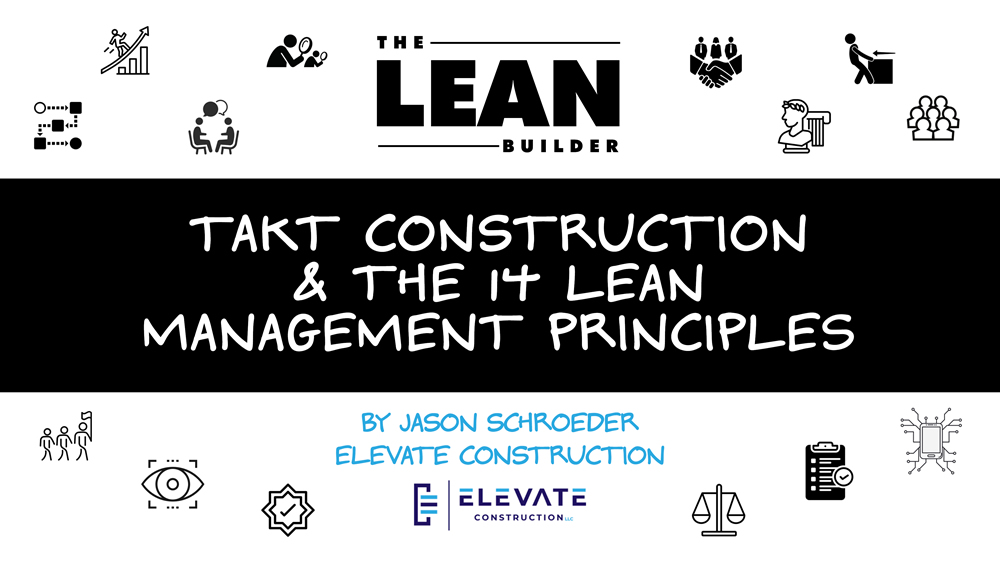When I was first introduced to Lean Construction, Jeffrey K. Liker’s book The Toyota Way was one of the first books I was asked to read. The 14 LEAN principles were so simple, understandable, and applicable to construction that I began posting printouts of them on 11×17 card stock and hung them from the ceiling in the office trailer. (If you don’t believe me just check out some of the videos on the LeanSuper YouTube channel.) I thought they were brilliant then, and I still do now.
Takt Construction
What I did not realize is how much they would impact me and my thinking. I, like many others in the industry, helped invent the Takt Production System. Now, hold on. Don’t get defensive here…. This is what I mean: People like Hal Macomber, Iris D. Tommelein, Janosch Dlouhy, Marco Binninger, The Porsche Consulting Group, Lean Communications, and many others were literally inventing it themselves independently all at the same time. It has only been a recent development that we are all sharing with each other and creating a full body of work explaining the system.
My journey started when I was able to learn SIPS from Hensel Phelps and developed my version of the system as a field superintendent. As I did that, I realized that each concept in the Takt Production System aligned with these 14 LEAN principles. Then, when I was able to learn from Marco, Janosch, Hal, and Iris, I realized the Takt Production System was the only construction scheduling system that perfectly aligned with all 14 concepts. To add to it, I was delighted when I read a more expansive work covering Lean principles in the book This Is Lean by Niklas Modig and Par Ahlstrom. Again, I realized that Takt aligned perfectly with the principles of Lean.
So, here is a bold statement. Takt with Last Planner System® (LPS) and Scrum is the Lean Construction scheduling system. And The Takt Production System is the construction scheduling equivalent of the Toyota Production System in manufacturing. To prove a portion of this point please allow me to share with you my reflections on each Principle of Liker’s book The Toyota Way.
14 Lean Management Principles
Principle 1 – Base your management decisions on long term philosophy, even at the expense of short-term financial goals.
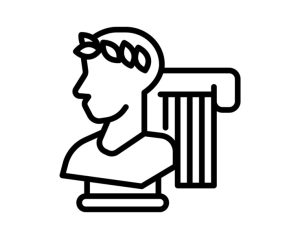 I love this principle. This applies to Takt in several ways. Let’s start with number 1. I have tracked over several years the hit rate between Critical Path Method (CPM) schedules and Takt schedule in Arizona and have found most industry CPM schedules to be within 20% of the actual realistic duration for the project—meaning I compared the bid schedule with the actual as-built duration once the project was complete. I also began comparing our macro-level Takt plans with as-built durations and found they were within 5%. So, here is the point. When you see a CPM schedule that gives you a pretty number that the team falls in love with, you may be basing your management decisions on short-term gains instead of a long-term philosophy. The bottom line is that Takt schedules, although more realistic and sometimes not as appealing at first, are more likely to accurately predict the realistic overall total project duration
I love this principle. This applies to Takt in several ways. Let’s start with number 1. I have tracked over several years the hit rate between Critical Path Method (CPM) schedules and Takt schedule in Arizona and have found most industry CPM schedules to be within 20% of the actual realistic duration for the project—meaning I compared the bid schedule with the actual as-built duration once the project was complete. I also began comparing our macro-level Takt plans with as-built durations and found they were within 5%. So, here is the point. When you see a CPM schedule that gives you a pretty number that the team falls in love with, you may be basing your management decisions on short-term gains instead of a long-term philosophy. The bottom line is that Takt schedules, although more realistic and sometimes not as appealing at first, are more likely to accurately predict the realistic overall total project duration
Number 2, as the industry heads toward replacing CPM with Takt, some companies are hesitant to make the change. I hope they do well, and I wish them the best, but this is a myopic decision. Takt is easier on the workers and harder to create by the project management team, but it is a real and reliable schedule. I believe not taking the time to invest in Takt planning is substituting perceived short-term financial goals with long-term management philosophies. There will be a time when companies must adopt the new system or be left behind.
Principle 2 – Create continuous process flow to bring problems to the surface. (Just In Time)
 Principle 2 has Takt written all over it. The very nature of a Takt plan is to format the schedule with time on the X axis and location on the Y axis. What is left in the intersections are Takt wagons that have trade processes packaged within. In a Takt plan you can see and keep these trades flowing perfectly from area to area in a beautiful diagonal line. This trade process flow then brings problems to the surface because project teams can see when trades are and are not going the same speed and the same distance apart. Additionally, because work is leveled from area-to-area and monitored in short-intervals, problems are vetted real-time. Takt construction puts everything on the project into a continuous process flow, and it allows the team to bring problems to the surface.
Principle 2 has Takt written all over it. The very nature of a Takt plan is to format the schedule with time on the X axis and location on the Y axis. What is left in the intersections are Takt wagons that have trade processes packaged within. In a Takt plan you can see and keep these trades flowing perfectly from area to area in a beautiful diagonal line. This trade process flow then brings problems to the surface because project teams can see when trades are and are not going the same speed and the same distance apart. Additionally, because work is leveled from area-to-area and monitored in short-intervals, problems are vetted real-time. Takt construction puts everything on the project into a continuous process flow, and it allows the team to bring problems to the surface.
Principle 3 – Use pull systems to avoid ‘overproduction’.
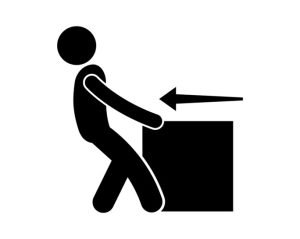 I have made a case for a while now that Lean Construction is based on Takt first and then pull. This is how it works at Toyota, and it is also how it works for us in construction. Construction projects should be turned into production lines with the zones receiving the value and the train of trades flowing through them on a Takt time. Then, materials, information, labor, equipment, layout, permissions, and all other needed support systems are pulled in at the right time to enable the install of work to happen on the Takt time. This works just like it does in a car manufacturing plant. In an assembly line the cars move through the factory on a Takt time, and then parts, motors, and other assemblies are pulled into the line as needed based on a Kanban system. That is also why Takt is paired with Last Planner and Scrum. Takt forms the production line, and LPS and Scrum pull needed resources into the line just at the right time. Takt with LPS and Scrum bring pull into construction so we can avoid ‘overproduction.’ One quick note here. When we avoid overproduction, we avoid excess inventory, motion, transportation, defects, overprocessing, and waiting.
I have made a case for a while now that Lean Construction is based on Takt first and then pull. This is how it works at Toyota, and it is also how it works for us in construction. Construction projects should be turned into production lines with the zones receiving the value and the train of trades flowing through them on a Takt time. Then, materials, information, labor, equipment, layout, permissions, and all other needed support systems are pulled in at the right time to enable the install of work to happen on the Takt time. This works just like it does in a car manufacturing plant. In an assembly line the cars move through the factory on a Takt time, and then parts, motors, and other assemblies are pulled into the line as needed based on a Kanban system. That is also why Takt is paired with Last Planner and Scrum. Takt forms the production line, and LPS and Scrum pull needed resources into the line just at the right time. Takt with LPS and Scrum bring pull into construction so we can avoid ‘overproduction.’ One quick note here. When we avoid overproduction, we avoid excess inventory, motion, transportation, defects, overprocessing, and waiting.
Principle 4 – Level out the workload. (Eliminate waiting)
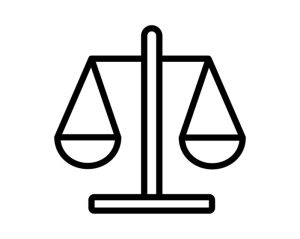 In a Takt plan we prioritize workflow and trade flow together which creates a plan that has continuity in the work and consistency in the flow of work from area to area. The primary basis of Takt planning is to protect that continuity and consistency by keeping trades going the same speed and the same distance apart, and by protecting the trade flow from area-to-area. Takt planning is designed to level out the workload because work is leveled from area-to-area and installed by consistent crews. In fact, Takt does this so well, it complies with all three main concepts listed in Little’s Law (as applied to construction) in that we reduce batch sizes, level the workload, and finish as we go.
In a Takt plan we prioritize workflow and trade flow together which creates a plan that has continuity in the work and consistency in the flow of work from area to area. The primary basis of Takt planning is to protect that continuity and consistency by keeping trades going the same speed and the same distance apart, and by protecting the trade flow from area-to-area. Takt planning is designed to level out the workload because work is leveled from area-to-area and installed by consistent crews. In fact, Takt does this so well, it complies with all three main concepts listed in Little’s Law (as applied to construction) in that we reduce batch sizes, level the workload, and finish as we go.
Principle 5 – Build a culture of ‘stopping to fix problems’ to get quality right. (Eliminate rework)
 One of the main options in handling a delay with Takt is to stop the line, fix the problem, and restart everyone together again. Now, this is not the only way to handle a delay. There are actually a few of them. Here they are in order:
One of the main options in handling a delay with Takt is to stop the line, fix the problem, and restart everyone together again. Now, this is not the only way to handle a delay. There are actually a few of them. Here they are in order:
- Stop the Takt train and swing to workable backlog.
- Stop the Takt train, wait, and prepare.
- Pull the delayed work out of the Takt plan and onto a separate pull plan or Scrum board.
- Pull the box car or Takt wagon out of the train and onto its own Takt time.
- Recover within the wagon or box car.
- Swarm the delay with swing capacity.
- Delay and individual zone. Be careful not to trade stack.
As you can see, the first two options are to stop. Stop and do what? Fix the problem is the answer. Takt is specifically designed to 1) optimize your schedule so you can have buffers; 2) get all trades moving the same speed at the same distance apart; and 3) allow you to stop the line and eat into your buffers if needed. Takt is a nimble and agile system that is perfectly suited to stop and fix problems as you go. There is little difference between stopping a production line of cars with an Andon and stopping a Takt train in construction. They both work from the exact same principles.
Principle 6 – Standardized tasks are the foundation for continuous improvement and employee empowerment.
 I will be brief with this one. Work can only be standardized when processes are repeated and improved based on a standard. Takt does this by packaging processes into Takt wagons and allowing the crew to measure their success from area to area. As the trade crew does so, they update their standard work. In normal schedules this cannot be done because every activity is different and organized without repetition.
I will be brief with this one. Work can only be standardized when processes are repeated and improved based on a standard. Takt does this by packaging processes into Takt wagons and allowing the crew to measure their success from area to area. As the trade crew does so, they update their standard work. In normal schedules this cannot be done because every activity is different and organized without repetition.
Principle 7 – Use visual controls so no problems are hidden. (Opportunities are exposed to all)
 If you looked up visual controls in a metephorical construction dictionary you would see a picture of a Takt plan. They are visual, easily understood, and on one page. There never has been an easier schedule to look at and use with your team. Takt plans enable everyone to see the plan, know the plan, and act on the plan. Even if all the other principles did not apply to Takt, this one principle would make the system worth your time. You cannot organize a team if they cannot see the plan together. So, if you want to get everyone on the same page, you have to see your schedule on one page.
If you looked up visual controls in a metephorical construction dictionary you would see a picture of a Takt plan. They are visual, easily understood, and on one page. There never has been an easier schedule to look at and use with your team. Takt plans enable everyone to see the plan, know the plan, and act on the plan. Even if all the other principles did not apply to Takt, this one principle would make the system worth your time. You cannot organize a team if they cannot see the plan together. So, if you want to get everyone on the same page, you have to see your schedule on one page.
Principle 8 – Use only reliable and thoroughly tested technology that serves your people and processes.
 I love this one. Takt remains easily made and remarkably effective in Excel. Yes, one day we will need software to handle analytics, AI automation, and historical data, but the bottom line is that Takt works very nicely with thoroughly tested software. It even works well by hand. It does not need a fancy computer program to work. That is why I love it. We cannot rely on schedules that only a computer can understand. If you need a computer to do the work for you, it is not simple enough for our boots-on-the-ground professionals to steer it in the field. So, Takt absolutely aligns with Principle 8—only use reliable and thoroughly tested technology.
I love this one. Takt remains easily made and remarkably effective in Excel. Yes, one day we will need software to handle analytics, AI automation, and historical data, but the bottom line is that Takt works very nicely with thoroughly tested software. It even works well by hand. It does not need a fancy computer program to work. That is why I love it. We cannot rely on schedules that only a computer can understand. If you need a computer to do the work for you, it is not simple enough for our boots-on-the-ground professionals to steer it in the field. So, Takt absolutely aligns with Principle 8—only use reliable and thoroughly tested technology.
Principle 9 – Grow leaders who thoroughly understand the work, live the philosophy, and teach it to others.
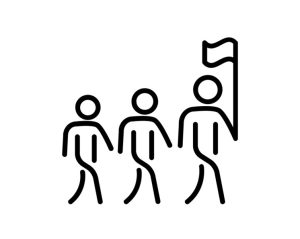 This is more of a signpost than it is a travelog, meaning this is where will have to go, not where we have been with Takt. Our next step with Takt is to grow leaders who thoroughly understand the system and can teach it to others. Without this, companies will continue to only scratch the surface of what Takt can do for their people and profits.
This is more of a signpost than it is a travelog, meaning this is where will have to go, not where we have been with Takt. Our next step with Takt is to grow leaders who thoroughly understand the system and can teach it to others. Without this, companies will continue to only scratch the surface of what Takt can do for their people and profits.
Principle 10 – Develop exceptional people and teams who follow your company’s philosophy.
 This principle again looks to the future. And here is a caution: If we continue to hire and promote people who only care about falsely pleasing clients, who only care about cutting the end date, and who don’t mind hurting people and crash-landing projects, we will not adopt Takt. Takt is a stable, respectful, and reliable system. Hot shots in our industry that marginalize people will not want the Takt system because it handcuffs them to proper and respectful behavior. Once that happens, they can only then rely on skill instead of reckless behavior. So, developing exceptional people and teams who care about and respect people is crucial if we ever want Takt to stick in our industry.
This principle again looks to the future. And here is a caution: If we continue to hire and promote people who only care about falsely pleasing clients, who only care about cutting the end date, and who don’t mind hurting people and crash-landing projects, we will not adopt Takt. Takt is a stable, respectful, and reliable system. Hot shots in our industry that marginalize people will not want the Takt system because it handcuffs them to proper and respectful behavior. Once that happens, they can only then rely on skill instead of reckless behavior. So, developing exceptional people and teams who care about and respect people is crucial if we ever want Takt to stick in our industry.
Principle 11 – Respect your extended network of partners and suppliers by challenging them and helping them improve.
 This is one we can begin now. Vendors will make more money with Takt. Trade partners will make more money with Takt. The owner will make more money with it. Everyone would benefit if they would slow down, cut the waste, and work in a flow. So, even though it is hard to convince owners, trades, and vendors, we must begin now to challenge them to work within this new system.
This is one we can begin now. Vendors will make more money with Takt. Trade partners will make more money with Takt. The owner will make more money with it. Everyone would benefit if they would slow down, cut the waste, and work in a flow. So, even though it is hard to convince owners, trades, and vendors, we must begin now to challenge them to work within this new system.
Principle 12 – Go and see for yourself and thoroughly understand the situation.
 Takt breaks the project up so you can see the situation. If you do not believe me, just print out your old, 76-page, black-and-white, detailed schedule, organized by WBS and not by area, and try to compare it with what is happening in the field. And then take out a Takt plan with Takt zone maps. You will immediately see that Takt allows you to thoroughly understand the situation because you can visualize work in the context of time and space. This allows the team to observe and recover delays in real-time, not weeks or months later.
Takt breaks the project up so you can see the situation. If you do not believe me, just print out your old, 76-page, black-and-white, detailed schedule, organized by WBS and not by area, and try to compare it with what is happening in the field. And then take out a Takt plan with Takt zone maps. You will immediately see that Takt allows you to thoroughly understand the situation because you can visualize work in the context of time and space. This allows the team to observe and recover delays in real-time, not weeks or months later.
Principle 13 – Make decisions slowly by consensus, thoroughly considering all options and then implement rapidly.
 We are on a roll now with these… When you have a delay in Takt, you must analyze the root cause, find a solution for the delay, determine a recovery plan that does not hurt trade flow, and really visualize and answer all the possible questions related to the change in the plan. With CPM no one ever does this. We just status the activity, dissolve some logic, throw labor, money, and materials at the problem, and hope it goes away. Takt on the other hand is the epitome of making decisions slowly by (visual) consensus and then implementing rapidly. You cannot fake a recovery plan or dissolve logic in a Takt plan when it is so visual. Your solution must be well thought-out and real.
We are on a roll now with these… When you have a delay in Takt, you must analyze the root cause, find a solution for the delay, determine a recovery plan that does not hurt trade flow, and really visualize and answer all the possible questions related to the change in the plan. With CPM no one ever does this. We just status the activity, dissolve some logic, throw labor, money, and materials at the problem, and hope it goes away. Takt on the other hand is the epitome of making decisions slowly by (visual) consensus and then implementing rapidly. You cannot fake a recovery plan or dissolve logic in a Takt plan when it is so visual. Your solution must be well thought-out and real.
Principle 14 – Become a learning organization through relentless reflection and continuous improvement.
 How can you learn from a schedule you cannot see? How can you improve processes that do not repeat? How can you leverage the wisdom of the team if they are not all on the same page. The answer is simple. In the Takt format, which is simple, visual, predictable, continuous, consistent, and standardized, any team, any crew, and any leader can make improvements constantly. Takt is the consistency that continuous improvement needs to work. Takt creates the backbone for continuous improvement on a construction site.
How can you learn from a schedule you cannot see? How can you improve processes that do not repeat? How can you leverage the wisdom of the team if they are not all on the same page. The answer is simple. In the Takt format, which is simple, visual, predictable, continuous, consistent, and standardized, any team, any crew, and any leader can make improvements constantly. Takt is the consistency that continuous improvement needs to work. Takt creates the backbone for continuous improvement on a construction site.
Whoa! That was a lot of information I know, but I hope you will agree the logic is thoughtful and thoroughly studied. The Takt system will overtake the industry in the next 3-5 years, and the prize will go to those companies who are early adopters. With the spreading of LPS, Scrum, and Takt we now have a complete picture of how to schedule for Lean Construction.

